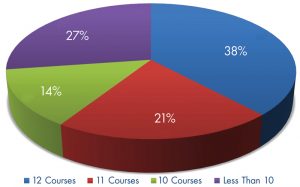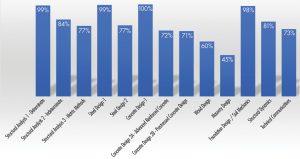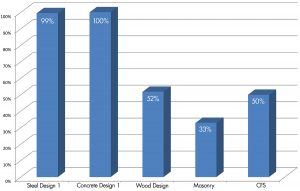The National Council of Structural Engineers Associations (NCSEA) is pleased to present the 2019 NCSEA Structural Engineering Curriculum Survey results. The survey is a triennial review of the recommended NCSEA Structural Engineering Curriculum at over 175 civil or architectural engineering schools throughout the country that offer educational opportunities for students desiring to become structural engineers. For nearly 10 years, NCSEA has promoted the recommended NCSEA Structural Engineering Curriculum as the core subject matter deemed necessary by the profession for a sound educational background in structural engineering. The recommended curriculum consists of the following twelve courses:
- Structural Analysis 1 – Determinate Structures
- Structural Analysis 2 – Indeterminate Structures
- Structural Analysis 3 – Matrix Methods
- Steel Design 1
- Steel Design 2
- Concrete Design 1
- Concrete Design 2 (A-Advanced Reinforced or B-Prestressed Concrete)
- Wood Design
- Masonry Design
- Structural Dynamics
- Foundation Design/Soil Mechanics
- Technical Communications
Full course descriptions can be found on the Basic Education Committee page of the NCSEA website (https://bit.ly/3taZ0M1). While these courses are recommended for a sound educational background, it is recognized by NCSEA that not all students will complete all of these courses before entering the workforce. Therefore, some post-graduate training will occur, whether formal (graduate school) or informal (on-the-job training), to further develop the engineer’s skill set. Subsequent to launching the curriculum survey, the committee launched a Practitioner Survey, sent to all NCSEA members to gather information about the structural engineering community’s desires from their new hires out of college. In this first of two articles developed by the NCSEA Basic Education Committee (BEC), curriculum survey results are reviewed. A subsequent article will compare results where academia and practitioners agree and disagree on courses that prepare students to transition to practicing engineers.
Survey Process
The NCSEA BEC began planning for the 2019 Curriculum Survey soon after the previous survey results were published in the (September 2016, STRUCTURE magazine). The list of schools contacted for participation in the 2019 survey was first verified by reviewing all engineering programs accredited by ABET as Civil Engineering, Architectural Engineering, and Structural Engineering. At this time, we do not include Civil Engineering Technology and Architectural Engineering Technology programs. There are 311 degree programs in either civil or architectural engineering at 283 schools in the U.S. Of these, there are 283 civil engineering programs and 28 architectural engineering programs. If the school participated in the 2016 survey, the same contact person was used for the 2019 survey. However, if the school had not responded to the previous survey, a contact was selected from information on the school’s website and was usually selected because they serve as chair of their department or taught structural engineering-related courses.
The NCSEA BEC obtained survey results from 176 of the 258 contacted schools. Please note that the survey results herein are based on self-reporting from the schools; BEC members have performed no outside verification of course offerings.
Graduation from an ABET-accredited program is the most common path towards achieving the educational requirement necessary for licensure. ABET does not require a set list of courses to be taught to engineering students at the undergraduate level. Instead, they provide a list of student outcomes and the number of credit hours that fall under the category of engineering topics, consisting of engineering sciences and engineering design appropriate to the student’s field of study. For the 2019-2020 academic years, ABET-accredited schools were required to provide a minimum of 45 semester hours (or equivalent trimester or quarter hours) that fall in this category. Once students complete the necessary foundational (statics, dynamics, mechanics of materials, etc.) and breadth courses within their area of study, undergraduate students are often left with only 16 to 24 semester hours of technical courses required to complete their degree. Therefore, at the conclusion of the average student’s undergraduate education, many have taken only four to six of the twelve BEC recommended courses.
Survey Results
Survey results revealed that only 38% of the responding schools offer all twelve courses at either the undergraduate or graduate level (Figure 1). However, if the scope is broadened to include all schools that offer at least 10 of the 12 recommended courses, 73% met this threshold.

A breakdown of the percentage of schools that offered each of the recommended twelve courses (Figure 2) revealed nearly all responding schools offered Structural Analysis 1, Steel Design 1, Concrete Design 1, and Foundation Design/Soil Mechanics courses. Likewise, a high percentage of schools offered seven out of the eight remaining courses. The only BEC recommended course that respondents indicated was offered by less than half of the responding schools was Masonry Design.

A further breakdown of materials courses (Figure 3) reveals a wide discrepancy in the percent of responding schools that offer courses in each material at the undergraduate level. As one would expect, Steel and Concrete Design 1 courses are nearly universal; however, the other design materials courses are offered at about half, or less, schools at the undergraduate level.

For each of these materials courses, the survey asked the schools to select no more than two of the following reasons why they did not offer a course in these materials: lack of demand from students, lack of school support, lack of research funding for the material, lack of professors with familiarity in the material, imposed unit restrictions, or lack of professor interest. The three top answers, which were pretty evenly split across the different materials, were: lack of demand from students, lack of professors with familiarity in the material, and imposed unit restrictions.
Student Organizations
In addition to academic opportunities offered at the various colleges and universities, the student’s exposure to structural engineering can be augmented by participation in student organizations. NCSEA member organizations have partnered with schools to establish student branches explicitly focused on structural engineering. To date, there are 25 student chapters of NCSEA. A brief check of ASCE’s website reveals over 300 ASCE student chapters in the United States. The Structural Engineering Institute, a subset of ASCE, also has student chapters for graduate students. Of the 176 responding universities, 11 had SEI student chapters. Other professional societies that have student chapters include ASCE’s Architectural Engineering Institute (15 of 176), National Society of Professional Engineers (14 of 176), Earthquake Engineering Research Institute (40 of 176), Engineers without Borders (92 of 176), and the American Concrete Institute (3 of 176).
Preparedness for Entering the Workforce
We polled the professors who responded to our curriculum survey to see if they felt the students who completed their undergraduate degree were “adequately prepared when entering the workforce.” Of the 176 respondents to the survey, only 12% responded, “most definitely; they have the tools and skills, and are ready to perform structural engineering.” The same question was asked regarding graduate students, and the percentage responding “most definitely” rose to 80%. These responses show a very clear delineation of where the academic world views the cutoff between having the basic tools and skills to enter the workforce.
The BEC sent out the practitioner survey to the members of NCSEA to collect information on the merit of the recommended courses and collect other data. The Practitioner Survey asked the same questions asked of the professors concerning the preparedness of students graduating with undergraduate degrees or graduate degrees to enter the workforce. Stay tuned for an upcoming article to review this survey’s findings and compare responses from consulting professionals and academia.
Conclusion
While NCSEA does not currently have a direct role at the table in formulating the academic requirements that students must meet for graduation, there are still opportunities for NCSEA members to support the outcomes for future professionals. We encourage you to participate in your alma maters or other connected schools actively. There may be opportunities to serve on a departmental advisory board and participate in curriculum discussions. As alumni, you can collaborate with faculty to initiate and cultivate a student chapter of NCSEA to augment the student’s experience. Alternatively, you can volunteer to give a lecture/club presentation to the students to discuss the profession, the merits of NCSEA, and promote the recommended curriculum to students who are selecting technical electives. Finally, find ways to engage students directly as a mentor to promote NCSEA’s recommended curriculum and positively affect their preparedness. With such efforts, NCSEA’s members can support students’ preparedness as they enter the workforce and become professional engineers.
Do you have an interest in continuing this important dialog between practitioners and academia, or would you like more ideas on engaging with academia? In that case, we invite you to reach out to Judy Liu or Scott Francis, Co-Chairs of the BEC Committee, for more information.■
